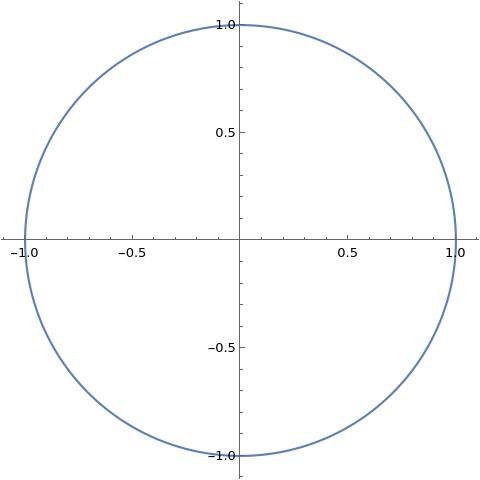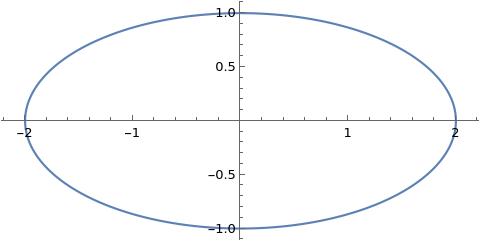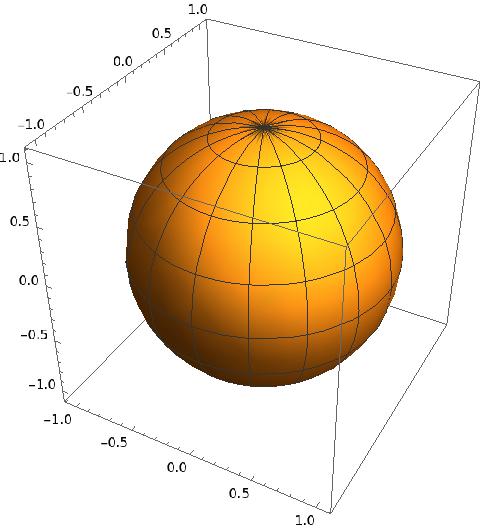1A partly topological introduction
The brief version is that an algebraic curve, or rather a plane algebraic curve, is the zero locus of a polynomial in two variables. To define this in more precision, let be a field. Then the zero locus of is
For and we get the well known unit circle.
 But we may also have more complicated curves like
But we may also have more complicated curves like
 given by , where .
The unit circle
has the (well?) known parametrization
Such a parametrization (with rational functions) always misses a finite number
of points on the curve. If you include transcendental functions, you can get
all the points (here with only running through a closed and bounded interval!) with the parametrization
Can you find a similar parametrization as in (1.1) for the (famous) curveThis curve is called the folium of Descartes in Figure (1.3)? Here
the rules of the game are: find rational functions , such that
where .
given by , where .
The unit circle
has the (well?) known parametrization
Such a parametrization (with rational functions) always misses a finite number
of points on the curve. If you include transcendental functions, you can get
all the points (here with only running through a closed and bounded interval!) with the parametrization
Can you find a similar parametrization as in (1.1) for the (famous) curveThis curve is called the folium of Descartes in Figure (1.3)? Here
the rules of the game are: find rational functions , such that
where .


Prove that and are irreducible
polynomials in .
Challenge
Prove that (the Fermat curve)
does not have solutions in the field of rational functions in the variable for . Here
is any field.
Studying mathematics a century ago, you would probably in a flash be able to spot that
You can see that Sage says about this indefinite integral by evaluating the window below.The algebraic curve given by is
parametrized by
How does this help you in computing an antiderivative of
? Carry out the computation using a computer algebra
system and verify that you get an antiderivative.The antiderivative
is a different story, partly because it is impossible to find a
rational parametrization of the algebraic curve .
Classically (and astronomically!) ellipses are extremely interesting. An
ellipse is an algebraic curve of the form for
where . It has the transcendental parametrization
 Kepler approximated the circumference using the formula . If you
want to compute the circumference precisely, you run into a bit of trouble when
trying find the antiderivative below
where .
Kepler approximated the circumference using the formula . If you
want to compute the circumference precisely, you run into a bit of trouble when
trying find the antiderivative below
where .

1.1 A few words about rational functions
The subset could be called an algebraic set. What are algebraic functions? To start with let us define rational functions There are many representatives for a rational function when defined as in (1.4). Just take a look at the example below for the rational functions in just one variable.
In an exercise in my first year course Introduction to mathematics and optimization, I asked students to analyze the behavior of the rational function
close to .
Clearly is not defined for , but it turns out that everything works
out, since
It looks like is not defined for , but
it is! It may be defined in one representation, but not in another.
A rational function can be restricted to an
algebraic curve and we may evaluate given by
a representative in a point provided that
(if is in the principal ideal , we are doomed). Here the representative for the rational function
is even more deceiving than in Example 1.8.
The unit circle is given by , where . The rational function
restricts to give a function on . Does this rational function haves poles
in and ? The funny thing is that when we restrict to
, then
as rational functions on .
Therefore is well defined at with value . The above identity leads to
the system
of linear equations over the subfield
with solutions
If you look closer, we have actually proved algebraically that the field
of rational functions (properly defined) on is isomorphic to
.
1.2 Topology
Recall that a topological space is a set with a topology. A topology is a subset of socalled open subsets, such that- if for .
- if .
Suppose that is a metric space with metric . What is the natural topology
associated with ?
A map
between topological spaces with topologies and is called continuous if for .If a continuous map is
bijective, then its inverse map is not necessarily continuous. If its inverse map is continuous, then the bijection is called a homeomorphism.
Give an example of a continuous bijective map whose inverse map
is not continuous.
A closed subset of a topological space is the complement of an open subset. Therefore
the axioms for a topological space might as well be given for the set
of closed subsets:
- if for .
- if .
1.2.1 Induced topology
A subset of a topological space carries the socalled induced topology, which is defined by
The closure of a subset is the smallest closed subset containing . It is the intersection of the closed subsets
containing . If
is an open cover, thenwhere denotes closure in the induced topology.
1.2.2 Quotient topology
Let be an equivalence relation on a topological space . The equivalence class containing is defined by Recall that . The set of equivalence classes is There is a natural topology on , such that is an open subset if and only if is open in . Here is the canonical map given by . This topology on is called the quotient topology on .
Prove that the quotient topology is a topology.
If is a topological group (group operations are continuous maps) and
a subgroup, then is naturally a topological space. Furthermore,
is an open map i.e., is an
open subset of . Recall that
Therefore is an open subset as
a union of open subsets in .
Consider and with and for . Then
is not an open subset.
1.2.3 Compactness
A topological space is called compact if every open cover has a finite subcover i.e., where is an open subset and is a finite subset. This is also a very cool and surprising definition. The result below is called the Heine-Borel theorem.
A subset of a euclidean space with the usual metric (and topology) is compact if and only if it is closed and bounded.
Give an example of a metric space, where closed and bounded subsets are
not necessarily compact.Hint
Consider .Hint
Along with the open covering given by
for .
The unit circle is
a compact topological space.
We also recall the following result, the proof of which is
surprisingly straight forward. Notice how clean the statement is.
No epsilons, no deltas. Just pure set theory.
Let be a continuous map between
topological spaces. Then is compact if is
compact.
A consequence of the above result is that a continuous function
on a compact topological space attains
its supremum and infimum.1.2.4 Hausdorff
A topological space is called Hausdorff if for every set of distinct point there exists open subsets , such that This notion has a nice interplay with compactness:
A compact subset of a Hausdorff topological space is closed.
Proving the above proposition also amounts to playing around with
the abstract concepts. Once you get down to it, the proof is
surprisingly short.From Theorem 1.19 it follows that
Let be a continuous map, where
is compact and is Hausdorff. Then is closed i.e.,
is a closed subset if is a closed
subset.
To elucidate the result above:
let denote the projection on the
first coordinate. Can you give an example of a closed subset ,
such that is not closed?
Give a precise proof that the topological spaces
are homeomorphic.
1.2.5 Product topology
We will briefly introduce the product topology. To simplify, we do this only for the product of two topological spaces and . The product topology on is defined as the smallest topology containing and , where is an open subset of and is an open subset of . So a subset is open if and only if for every , there exists open subsets and , such that and .You should check that a topological space is Hausdorff if and only if the diagonal is closed in the product topology.1.2.6 Connectedness
A topological space is connected if it is not the disjoint union of two non-empty subsets. If is a continuous map, then is connected if is connected.1.2.7 Irreducibility
This is a notion you may not have seen before.A topological space is called irreducible if it is not the union of two proper closed subsets.
What are the irreducible subsets (as topological spaces) of ?
1.2.8 Complex vector spaces
The set is a normed vector space over with It is perfectly ok to view as as a topological space. In fact, if and , then we have in that
Prove that is not a compact topological space.
Let be a non-constant polynomial in two variables. Prove
that is not a compact topological space.
1.3 Compactification
1.3.1 The real line
The solution in (1.5) gives us a bijective continuous map (a homeomorphism!) given by where . I find it intriguing that an infinitely large set of numbers, such as can be curled into the compact space except for one point. This construction is an example of a socalled compactification. It turns out that every algebraic curve has one.
Prove precisely that in (1.6) is a homeomorphism.
1.3.2 The famous Riemann sphere
In section 1.3.1 we embedded in the compact topological space by merely adding one point to ! It turns out we can do the same with . Topologically the compactification is the unit sphere in i.e.,
Let be stereographic projection from the
south pole i.e.,
Let . Prove that
and that is not holomorphic. Can you make
a small adjustment to so that becomes
holomorphic? With this adjustment the Riemann sphere becomes a Riemann surface!
If you have a sequence of complex numbers tending to infinity, then
they actually converge (!) on the Riemann sphere to - the north pole. Riemann defined
with the extended arithmetic
for . In this round about way, we may for example view
as a continuous function
with and .1.4 Projective spaces
For a field we let denote the set of lines through in i.e., where . Notice that if and only of for . This in fact gives an equivalence relation on and we may make the identification and write
We let denote the subset
Notice that we have bijective maps given by
If carries a topology, then can be equipped
with the quotient topology.
is a compact topological space.
Use the surjective continuous map given by
where
Here is a closed and bounded subset of .
Why is projective space interesting? Because it is a remarkable abstraction of the
Riemann sphere. In fact, we have
is homeomorphic to the Riemann sphere .
This is perhaps not such a big surprise, since , where
.
Define a metric , which
gives the topology on . Prove that the distance from
to is
where . In particular, .
A polynomial is called homogeneous if all its terms have the same degree.
is not a homogeneous polynomial, since it has terms of degree zero and two, whereas is a
homogeneous polynomial in with each term of degree two.
Let and .Consider as
an open subset of using the injective map
given by By abuse of notation, we let denote .
- Show that for .
- Explain why is a well defined subset of .
- Show that is a closed subset of .
- consists of only two points! Find them.
- Prove that in .